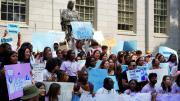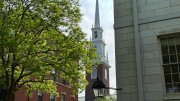This round-up is part of Harvard Magazine’s series “At Home with Harvard,” a guide to what to read, watch, listen to, and do while social distancing. Read the previous selections, featuring articles about income inequality, racial justice, Pride month, and more, here.
Migration is as old as humankind, yet it’s also newly urgent and contentious across the world—and will surely be made more so by the acceleration of climate change. Here, we’ve compiled a range of nuanced and humane perspectives on immigration and displacement covered in Harvard Magazine in recent years, including a new feature on undocumented young people that’s particularly vital in light of the U.S. Supreme Court’s recent ruling on DACA. The selections below represent disciplines from economics to the visual arts, all essential to a full picture of the immigrant experience.
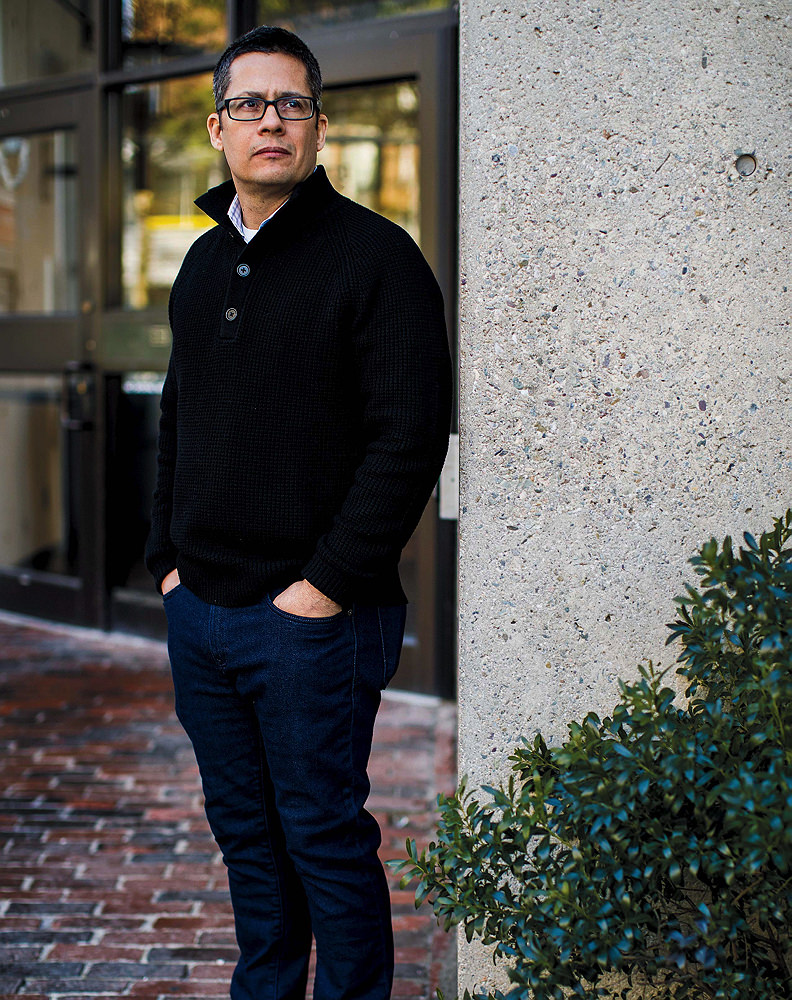
Ethnographer Roberto Gonzales spent 12 years following the lives of undocumented young people.
Photograph by Adam Glanzman
For the July-August 2020 issue, I wrote "From Neither Here Nor There," a profile of Harvard sociologist Roberto Gonzales, who for nearly three decades—first as a youth worker and later as a scholar—has studied the lives of undocumented people who arrived in the United States as young children, and has chronicled what happens as they grow up and become adults. And this is what he’s found: that, beginning in adolescence, their illegal immigration status takes on increasing importance in their identity, exerting a powerful downward force on their lives. “A lead weight that eventually drags you down,” Gonzales calls it. Illegality shapes their futures more strongly than anything else—talent, personality, family, work ethic, education. College graduates and high-school dropouts often find themselves working side by side in the same dead-end jobs.
A couple of weeks ago, when the U.S. Supreme Court ruled against the Trump administration’s attempt to terminate DACA, I thought not only of the program recipients I’d spoken to for the story and the ones whom Gonzales had surveyed, but also of the young people in his first study. For nearly all of them, DACA came too late. “They were the poster children of the DREAM Act,” he told me, meaning the 2001 legislation, never passed, that would have offered them a path to citizenship. Instead, year after year, their lives unfolded without it. By 2012, when DACA was created, “They were no longer the fresh-faced picture of open possibility that policymakers want to craft a narrative around,” Gonzales says. Many were by then too old for the program, or otherwise ineligible, or they couldn’t afford the $500 filing fee. They had kids of their own, they were working often physically taxing jobs, struggling financially. “In many senses, they are a lost generation,” Gonzales told me. “I think this is a really important point. It’s important for thinking about what policies we might implement going forward, and the very serious impacts on real people’s lives.”
~Lydialyle Gibson, Associate Editor
The stunning photos in “In Flight” document a humanitarian crisis at a level of immediacy and closeness that is so difficult to capture and rare to see. The pictured refugees rejoice in the help they receive as they enter Greece, fleeing endless wars, fear, and poverty in their home countries. But their struggles are far from over, as described by the collection’s photographer, Nieman Fellow Maciek Nabrdalik: “For at least several weeks, these people will become a shapeless migration mass, associated by European Union countries with ‘imposed quota policies,’ a dangerous, foreign wave of immigrants flooding Europe. They will face weeks of waiting, arduous journeys on foot, by train, bus. They will experience bleak conditions, uncertainty, humiliation and pain. But their persistence will endure.”
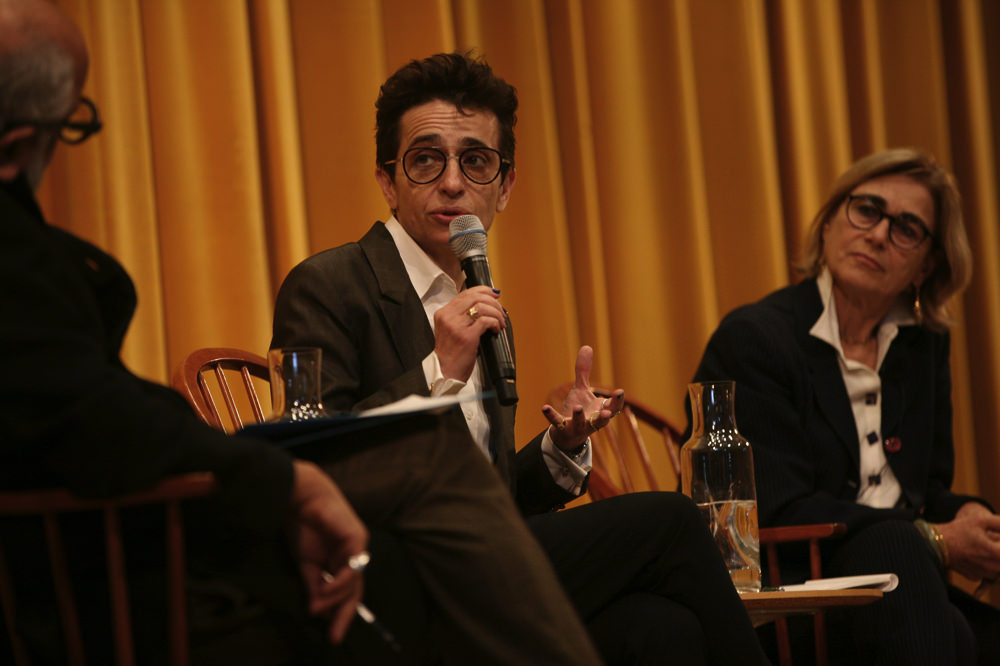
Homi Bhabha (left), Masha Gessen (center), and Jacqueline Bhabha (right)
Photograph by Tia Ann Chapman
In the first of two lectures at Harvard, Russian-American journalist and author Masha Gessen shared a flurry of 57 stories of immigration, narrated in just under an hour. The presentation, like the examples themselves, was destabilizing. Based on Gessen’s reporting, the stories of immigration and displacement stretched back to Gessen’s reporting on the Kosovo War in the 1990s and covered those displaced for their ethnicity, sexuality, and politics. The stories were presented back to back, each read from an individual notecard. Language, Gessen argued, has a powerful effect on how immigration is understood. Words like “illegals,” “undocumented,” “hordes,” “caravans,” even the word “migrant” itself, shape how displaced people are viewed, Gessen said, urging journalists to take a more careful look at the language they use to describe immigration. This account, by associate editor Marina Bolotnikova, gets at the heart of Gessen’s presentations with grace and focus.
~Jacob Sweet, Staff writer/editor
In “When Water Is Safer than Land,” Jacqueline Bhabha, professor of the practice of public health and human rights, writes brilliantly about the 2015 refugee crisis (remember that?). “We need a new paradigm for thinking about twenty-first-century ‘distress migration,’ because the post-World War II framework that still governs our laws and procedures is, in practice, defunct,” she asserts. She explains the dichotomy that underlies modern immigration law, separating “real” refugees from “economic migrants” in search of prosperity—and argues for a new migration system that transcends it. There is so much in this insightful piece, and it will help you understand the limits of international refugee law.
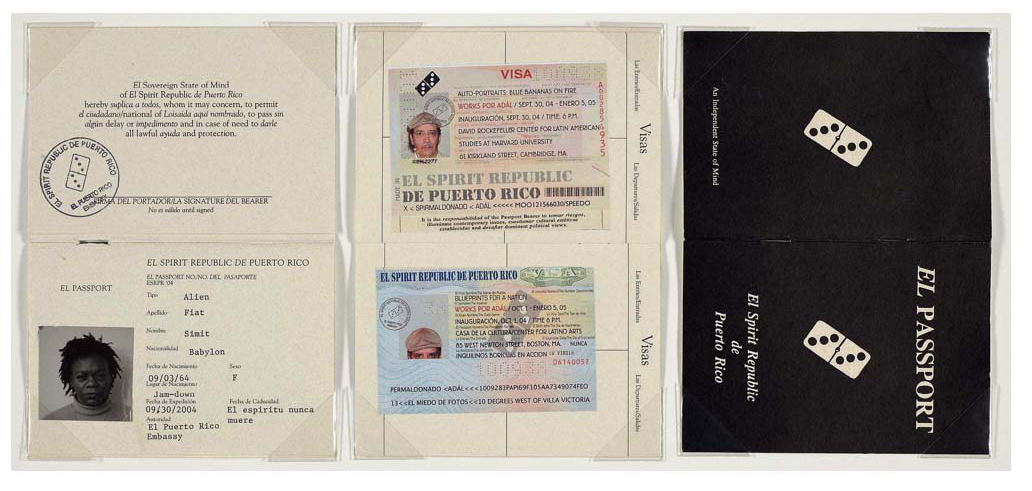
Adál Maldonado’s The Passport, 1995, from the series The Spirit Republic of Puerto Rico.
Transfer from the David Rockefeller Center for Latin American Studies, Harvard University, Gift of the artist, 2012.178. © ADзL. Image courtesy of Harvard Art Museums/Fogg Museum
Though our immigration conversation takes place mostly in news headlines, the immigrant experience lends itself particularly well to art. In “Made Visible,” I wrote about a recent Harvard Art Museums exhibit exploring migration, displacement, and the in-between questions of identity and assimilation and home, all too often missing from our acrimonious immigration discourse.
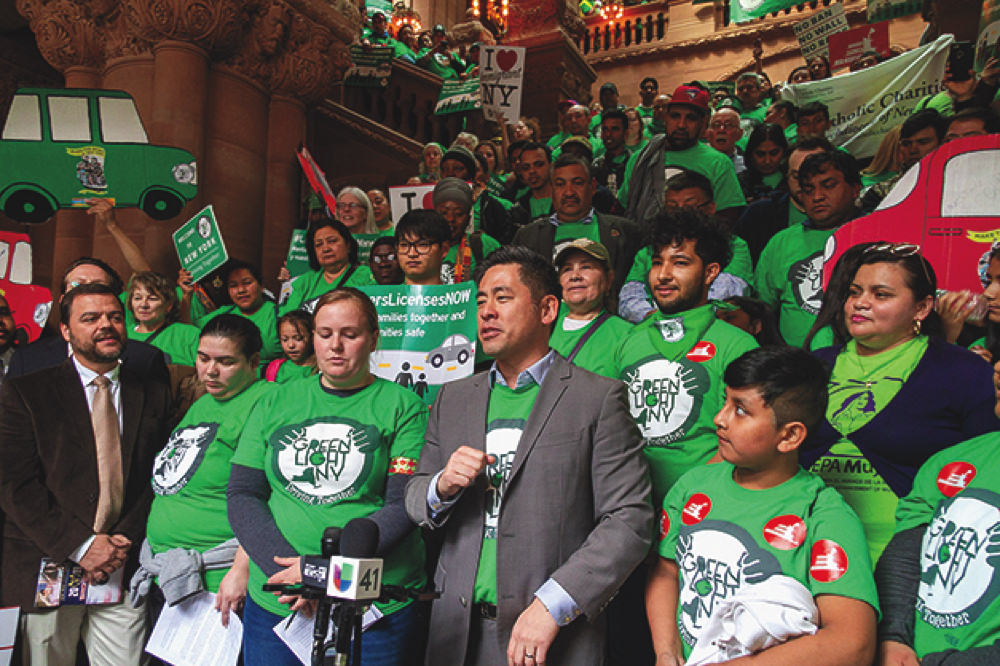
Choi and supporters gathered at the New York state capitol last year to urge passage of new driver’s license legislation.
Photograph courtesy of the New York Immigration Coalition
In “Rallying Cries,” Harvard Magazine writer Nell Porter Brown profiles Steven Choi, J.D. ’04, the fierce immigrant advocate who directs the New York Immigration Coalition. “We need to rebuild a new, expansive, forward-facing vision for what we think a strong immigration system should be,” he says, “engaging with presidential candidates, figuring out what leverage we can use to get them to align with us—all while responding to the continued distortion of an immigration system designed by white supremacist Stephen Miller and the Trump administration.” For more background on some of the policies Choi is criticizing, I wrote “Crimmigration,” a story on the criminalization of immigrants—a growing issue of research and advocacy at Harvard Law School.
~Marina Bolotnikova, Associate Editor
An outsized proportion of innovation in the United States comes from high-skilled immigrants, who cluster in areas where specialized industries have sprung up, but bring benefits to the entire country. One-third of the nation’s Nobel laureates since 1901 have been immigrants. Forty percent of doctoral degrees in the U.S. are awarded to noncitizens. More than a quarter of U.S. entrepreneurs were born overseas, according to one estimate, and immigrants appeared to account for just under a third of all U.S. patents in 2017. “The Innovation Engine,” explains D’Arbeloff-Class of 1955 professor of business administration William R. Kerr, could be made even better through immigration reforms, such as “guaranteed work visas for non-citizen graduates of U.S. colleges, an increased H-1B minimum wage, better allocation of scarce visas through wage-ranking (prioritizing those immigrants who will receive the highest wages from their sponsoring companies), and a preference for immigrant entrepreneurs.” (The Trump administration recently suspended entry into the United States of H-1B visa holders through the end of this year.)
~Jonathan Shaw, Managing Editor
More from “At Home with Harvard”
- Spring Blooms: Your guide to accessing the Arnold Arboretum as the seasons turn in Boston
- Harvard in the Movies: Our favorite stories about Harvardians on screen
- The Literary Life: Our best stories about the practice and study of literature
- Night at the Museum: Our coverage of Harvard’s rich museums and collections
- Nature Walks: Walking, running, and biking in Greater Boston’s green spaces, even while social distancing
- Supporting Local Businesses: Our extensive coverage of local restaurants and retailers, and how you can support them during this time of crisis
- Medical Breakthroughs: Our best stories going deep into the ideas and personalities that will shape the medical care of tomorrow
- Rewriting History: From race and colonization to genetics and paleohistory, our favorite stories about the people reshaping the study of history
- The Climate Crisis: Highlights from our wide-ranging coverage of the environment
- Crimson Sports Illustrated: With 2020 winter sports ending early and the spring collegiate season wiped out almost entirely, we look back at Crimson highlights from past years.
- The Real History of Women at Harvard: Stories covering the admission of women, the Harvard-Radcliffe merger, the rise of women in the faculty ranks, Harvard’s first woman president, and more
- The Undergraduate: Our favorite student essays on the undergraduate experience
- The Secret Lives of Animals: From zoology and evolutionary science to animal-rights law to the joys of local wildlife, a selection of our favorite animal stories
- Harvard on the Small Screen: Our coverage of the creators, writers, and actors in your favorite TV shows
- Extraordinary Lives: From our “Vita” section, extraordinary profiles of authors, artists, activists, and more
- Great Legal Minds: Our favorite stories on the minds reshaping American law
- Harvard History through a New Lens: Some of our most notable stories about obscure, dark, or surprising episodes in Harvard’s history
- Health and Fitness: Our extensive coverage of Harvard’s breakthough health and wellness research
- Pride Month: Stories of Harvard's LGBTQ life, research and history
- Inequality in America: Stories of America’s extreme inequality

